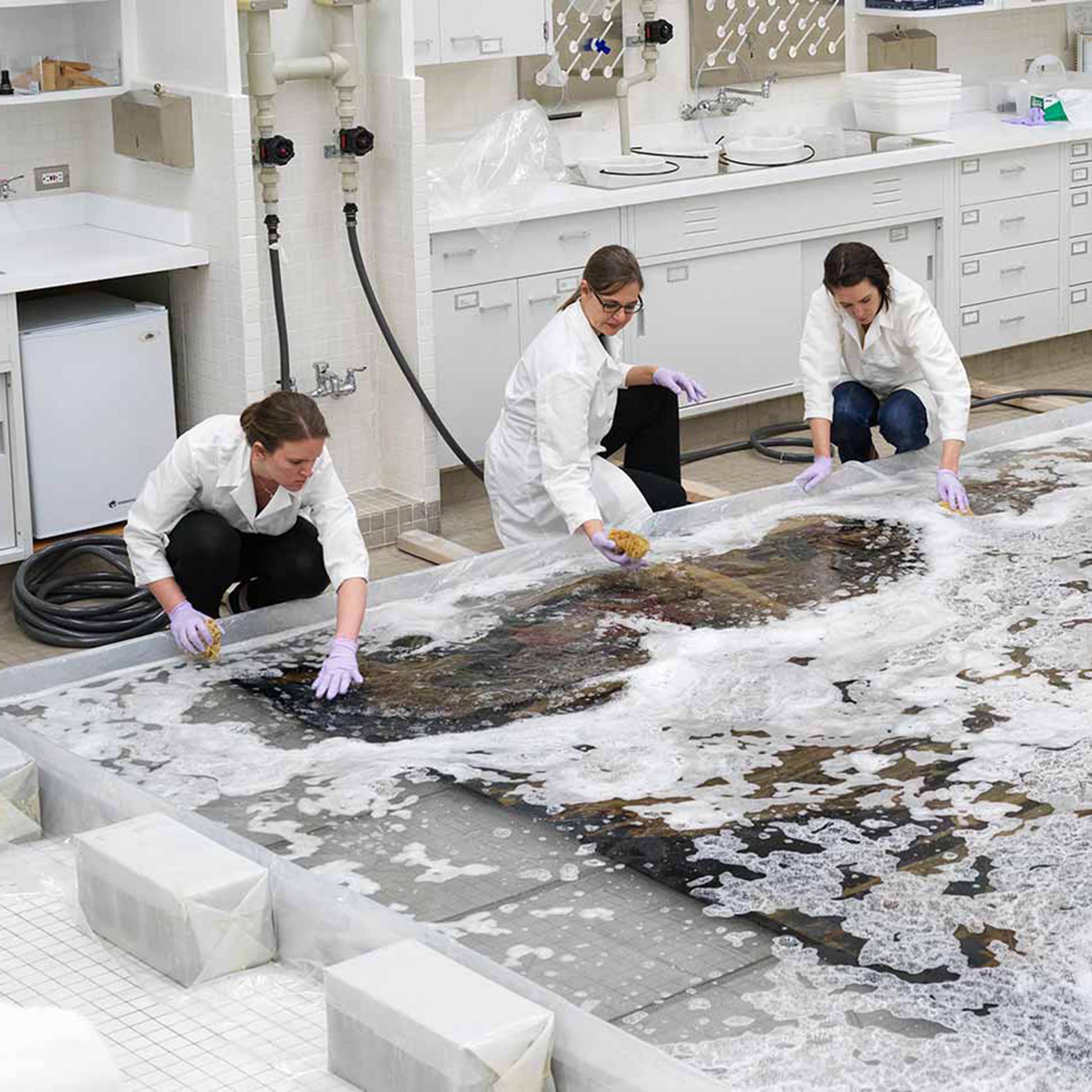Textile Conservation
About Us
The Department of Textile Conservation is responsible for preservation, conservation, technical study, and research of the Museum’s collection of approximately 36,000 textiles in twelve curatorial departments. The encyclopedic collection represents a broad range of textiles including tapestries, carpets, embroideries, costumes, and three-dimensional accessories of all periods and cultures. The Department sets guidelines for care, handling, display and storage of the textiles, and has played a key role in the Met’s initiative to create a dedicated facility for Integrated Pest Management (IPM) with a purpose-built freezer and pre- and post-treatment areas.
Integral to the Department’s practice is the systematic study, documentation, and scientific investigation of textiles. As research advances, the Department is steadily building and refining its digital collection-based database. The latest analytical equipment and methodology together with traditional methods are used for studying The Met’s collection and related textiles, materials and techniques. Thirteen professionals with diverse areas of expertise, as well as fellows, interns, and volunteers comprise the department.
Since its founding in 1973, the Department has contributed to the education of many conservators now in professional practice throughout the world. Committed to the training of future conservators through The Met’s Fellowship and Internship programs, the Department also supports externships and collaborations with conservators already working in the field fostering a worldwide network for collegial exchange.
The Department of Textile Conservation became an independent entity in 1973, under the leadership of Nobuko Kajitani, Conservator in Charge, until her retirement in 2003. Kajitani’s object-centered approach emphasized close examination of materials and techniques and the importance of an integrated historical and scientific approach in understanding and preserving the cultural legacies of textiles.
In 1973, textiles were stored either in the Textile Study Room or in curatorial storerooms throughout the museum. The renovation of the American Wing in the early 1980s provided an opportunity to incorporate a dedicated storeroom and workroom to meet the needs of the growing collection of American textiles. Nobuko Kajitani along with Elena Phipps, conservator at that time for American textiles, worked closely with the architects in every aspect of the project, including purpose-built cabinets and integrated conservation and viewing areas. The subsequent American Decorative Arts storeroom attracted wide attention for its innovative collections care of textiles.
In the late 1980s, Antonio Ratti provided funds for a comprehensive center to accommodate textiles from all curatorial departments. Under the visionary leadership of Nobuko Kajitani, the design included a state-of-the-art centralized storage for textiles with adjacent study rooms to provide for both staff and public access as well as a laboratory for the Department of Textile Conservation.
During the planning period, the department was tasked with assessing the long-term preservation needs of the Museum’s textile collection. This project provided an unprecedented opportunity for conservators to review the existing conditions in the collection, to re-evaluate the storage format, to plan and design the new storage facilities, and to transfer and consolidate the textile collection from storage in individual curatorial departments to a new common storage facility. The resulting database was integrated into TMS (The Museum System), a museum-wide initiative. The Department of Textile Conservation evolved from an 800-square-foot room to the current 9,400-square-foot state-of-the-art facility.
The TMS database, a digital innovation at the time, was based on information from catalogue cards and required increasing computer literacy for all involved in this project. This unique history resulted in the Department’s early adopting of new technology across a broad range of applications with analytical equipment.
Following Kajitani’s retirement in 2002, Florica Zaharia continued as Conservator-in-Charge until October 2016. Under Zaharia’s leadership the Department continued to build on its scholarly foundation, refining a collection-based comprehensive digital database including technical information and high-resolution analytical images of historic textiles from raw material to finished product.
Conservator-in-Charge Janina Poskrobko continues to support innovative applications of emerging digital technology in refining a collection-based, comprehensive digital database, including technical information and high-quality photo micrographs. The Department is currently working on compiling information in a format that will appear on the Departmental landing page of the Met’s website.
Over the years, textile conservators have contributed to a number of exhibitions with the rich content resulting from analytical research with state-of-the-art technology. Some of these exhibitions include Making the Invisible Visible: Conservation and Islamic Art (2013), Examining Opulence: A Set of Renaissance Tapestry Cushions (2014–2015), Scenes from the Life of St. Martin: Franco-Flemish Embroidery from the Met Collection (2015), The Secret Life of Textiles: Plant Fibers (2016), The Secret Life of Textiles: Animal Fibers (2017), Carpets for Kings: Six Masterpieces of Iranian Weaving (2017), and Portable Storage: Tribal Weavings from the Collection of William and Inger Ginsberg (2017–2018).
To date, the Department’s Pinterest and Instagram accounts have showcased research in an image-based format. The pandemic fast-tracked the adopting of social media platforms in cultural institutions worldwide promoting the sharing of collections and providing access to scholarly research. The Department of Textile Conservation will continue to take an active role in using emerging technology to disseminate information.
In 2023, The Met celebrated the Department of Textile Conservation's 50th anniversary. Read Conserving Our Textile Heritage (PDF) to learn more about the history of the department.
Research
Watch videos from the Department of Textile Conservation's Winter 2018 Colloquium.
Curators and conservators present on how The Met preserves and exhibits textiles in celebration of the 20th Anniversary of the Antonio Ratti Textile Center and department of Textile Conservation.
Articles, Audio, and Video
Featured
Discover how the idea to design a custom shawl for our department's 50th anniversary emerged, and see the textiles from around the world that served as sources of inspiration.
The Latest
- Immaterial | Audio
Immaterial: Blankets and Quilts
- Video
Textile Conservation at The Met
- Video
Conserving the King Arthur Tapestry
- Frame of Mind | Audio
Mending Hope
- Video
Reinstalling Art of Native America: Three Perspectives
- Video
Revisiting Art for the Community
